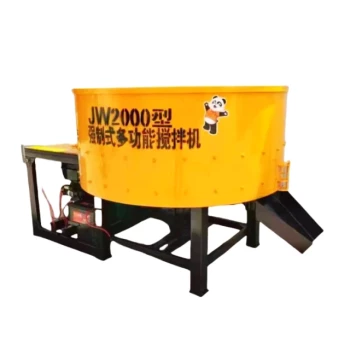Drum mixers, while efficient for large-scale concrete production, inherently offer limited control over mix quality due to their design and operational constraints. These limitations stem from fixed drum sizes, restricted adjustability of mixing parameters, and challenges in precise ingredient monitoring. However, modern drum mixer machine models incorporate control panels with rotation regulation and variable speed options to mitigate some of these issues. The trade-off between high-volume output and mix customization remains a key consideration for purchasers.
Key Points Explained:
-
Fixed Drum Design Limitations
- The rigid structure of drum mixers restricts the maximum batch volume and requires fixed material ratios for optimal mixing.
- This design reduces flexibility in customizing mix designs (e.g., adjusting aggregate sizes or additive proportions mid-batch).
- Have you considered how project-specific mix requirements might conflict with these fixed parameters?
-
Limited Adjustability of Mixing Parameters
- While some models offer variable speed and rotation controls, the drum’s angle and rotational dynamics are less customizable than in pan or twin-shaft mixers.
- Inconsistent mixing can occur when trying to blend specialty materials (e.g., fibers or lightweight aggregates) without precise speed modulation.
-
Challenges in Ingredient Monitoring
- Real-time adjustments to water content or admixtures are difficult due to the enclosed drum design, potentially leading to over/under-hydration.
- Modern sensors help but can’t fully replicate the precision of open mixer systems where visual checks are possible.
-
Operational Trade-offs
- Drum mixers prioritize high-volume output and portability—benefits that often outweigh mix control limitations for large infrastructure projects.
- For niche applications requiring exacting quality standards (e.g., architectural concrete), alternative mixer types may be preferable.
These constraints highlight how equipment choices silently shape construction outcomes, balancing productivity against material performance.
Summary Table:
| Constraint | Impact on Mix Quality | Modern Mitigations |
|---|---|---|
| Fixed Drum Design | Limits batch volume and mix customization (e.g., aggregate size adjustments). | Control panels with rotation regulation. |
| Limited Adjustability | Inconsistent mixing for specialty materials (e.g., fibers). | Variable speed options in newer models. |
| Ingredient Monitoring | Difficult real-time adjustments (e.g., water content). | Advanced sensors for better monitoring. |
| Operational Trade-offs | Prioritizes high-volume output over precision for niche applications. | Alternative mixer types for exacting quality standards. |
Need precise concrete mix control for your project? GARLWAY specializes in high-performance construction machinery, including drum mixers with advanced control features. Whether you're working on large infrastructure or niche applications, our solutions balance productivity and quality. Contact us today to discuss your requirements and explore the right mixer for your needs!
Related Products
- Ready Mixer Machine for Construction Ready Mix Machinery
- Concrete Cement Mixer Machine Drum Mixer for Construction
- Shaft Mixer Machine for Cement and Regular Concrete Mixing
- Commercial Construction Mixer Machine for Soil Cement Mixing Concrete
- Auto Concrete Cement Mixer Machine New
People Also Ask
- What are the benefits of concrete mixer machine? Boost Efficiency & Quality in Construction
- What are the 4 classifications of concrete mix? Essential Guide for Construction Pros
- How to choose the right concrete mix? Key Factors for Strength & Durability
- Are there different types of concrete mix? Explore Varieties for Optimal Construction
- How does concrete not harden in a truck? The Science Behind Workable Concrete












